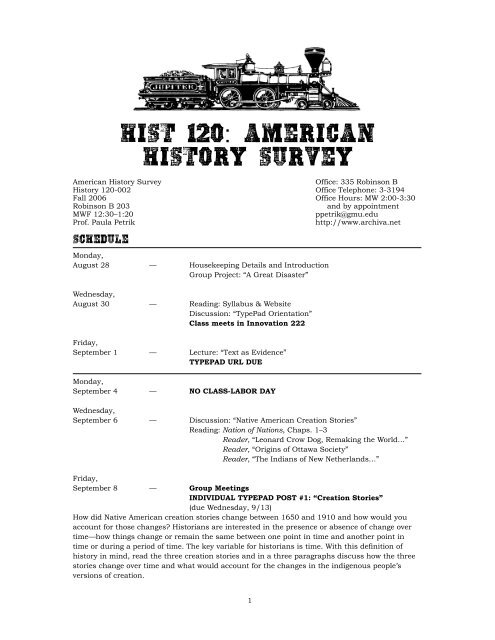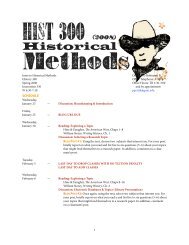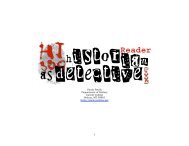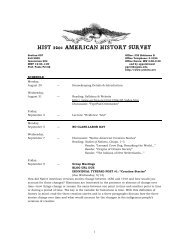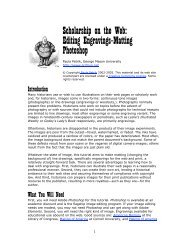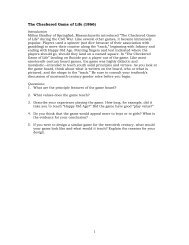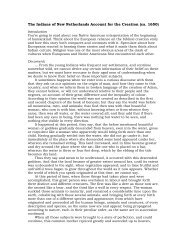Download HIST 120 Syllabus PDF - Paula Petrik | George Mason ...
Download HIST 120 Syllabus PDF - Paula Petrik | George Mason ...
Download HIST 120 Syllabus PDF - Paula Petrik | George Mason ...
You also want an ePaper? Increase the reach of your titles
YUMPU automatically turns print PDFs into web optimized ePapers that Google loves.
<strong>HIST</strong> <strong>120</strong>: AMERICAN<br />
<strong>HIST</strong>ORY SURVEY<br />
American History Survey<br />
Office: 335 Robinson B<br />
History <strong>120</strong>-002 Office Telephone: 3-3194<br />
Fall 2006 Office Hours: MW 2:00-3:30<br />
Robinson B 203<br />
and by appointment<br />
MWF 12:30–1:20<br />
ppetrik@gmu.edu<br />
Prof. <strong>Paula</strong> <strong>Petrik</strong><br />
http://www.archiva.net<br />
SCHEDULE<br />
Monday,<br />
August 28 — Housekeeping Details and Introduction<br />
Group Project: “A Great Disaster”<br />
Wednesday,<br />
August 30 — Reading: <strong>Syllabus</strong> & Website<br />
Discussion: “TypePad Orientation”<br />
Class meets in Innovation 222<br />
Friday,<br />
September 1 — Lecture: “Text as Evidence”<br />
TYPEPAD URL DUE<br />
Monday,<br />
September 4 — NO CLASS-LABOR DAY<br />
Wednesday,<br />
September 6 — Discussion: “Native American Creation Stories”<br />
Reading: Nation of Nations, Chaps. 1–3<br />
Reader, “Leonard Crow Dog, Remaking the World…”<br />
Reader, “Origins of Ottawa Society”<br />
Reader, “The Indians of New Netherlands…”<br />
Friday,<br />
September 8 — Group Meetings<br />
INDIVIDUAL TYPEPAD POST #1: “Creation Stories”<br />
(due Wednesday, 9/13)<br />
How did Native American creation stories change between 1650 and 1910 and how would you<br />
account for those changes? Historians are interested in the presence or absence of change over<br />
time—how things change or remain the same between one point in time and another point in<br />
time or during a period of time. The key variable for historians is time. With this definition of<br />
history in mind, read the three creation stories and in a three paragraphs discuss how the three<br />
stories change over time and what would account for the changes in the indigenous people’s<br />
versions of creation.<br />
1
Monday,<br />
September 11 — Lecture: “Evidence: Images”<br />
Reading: Nation of Nations, Chaps. 4–6<br />
LAST DAY TO ADD CLASSES<br />
Wednesday,<br />
September 13 — Discussion: Writeboard Orientation<br />
Class meets Innovation 222<br />
Friday,<br />
September 15 — Group Meetings<br />
GROUP TYPEPAD POST #2<br />
(due Wednesday, 9/20)<br />
How did the British view the Patriots’ activism in the period leading up to the Revolutionary War?<br />
Carefully examine the cartoon, “Society of Patriotic Women, Edenton, North Carolina.” Use the<br />
questions accompanying the online materials as well as your notes from the lecture to help<br />
develop your thesis and organize your evidence.<br />
Monday,<br />
September 18 — Lecture: “What Happened to Paul Revere”<br />
Reading: Nation of Nations, Chaps. 7–9<br />
Wednesday,<br />
September 20 — Lecture: “The Election of 1800”<br />
Friday,<br />
September 22 — Group Meetings<br />
COMMENT TYPEPAD POST #3<br />
(due Wednesday, 9/27)<br />
Select three entries from three different class participants in your assigned response group and<br />
comment on their entries. The comments should be about a paragraph in length and may<br />
address any aspect of the post, but you should offer at least one positive remark and at least<br />
three suggestions for improvement. Once you’ve made your comments, write a line or two in your<br />
own post with links to your comments. The links should appear in the following form: Mary<br />
Smith, Individual Post #1; Group #1, Group Post #2; John Jones, Individual Post #2.<br />
2
Monday,<br />
September 25 — Lecture: “Jacksonian America”<br />
Reading: Nation of Nations, Chap. 10–12<br />
Reader, “<strong>George</strong> Catlin’s Indians”<br />
Wednesday,<br />
September 27 — Lecture: “The Benevolent Empire”<br />
Friday,<br />
September 29 — Group Meetings<br />
LAST DAY TO DROP CLASSES<br />
INDIVIDUAL TYPEPAD POST #4: “<strong>George</strong> Catlin’s Indians”<br />
(due Wednesday, 10/4)<br />
Using Pigeon’s Egg Head as an example, what is Catlin’s view of Native Americans and their<br />
culture? Historians are interested in the “historical context,” the time, events, culture, society in<br />
which events took place or in which people lived and how the historical context may have (or not)<br />
influences historical events and actors. Catlin painted his works between in the decades between<br />
1830 and 1850, a time of transformation for the nation’s indigenous people. What was the<br />
historical context for Catlin’s paintings?<br />
Saturday<br />
September 30–<br />
Wednesday,<br />
October 27, 2006<br />
ELECTIVE WITHDRAWAL PERIOD (Full-Semester Course)<br />
Monday,<br />
October 2 — Lecture: “Evidence: Maps”<br />
Reading: Nation of Nations, Chaps. 13–14<br />
Wednesday,<br />
October 4 — Discussion: Hygeia<br />
Reading:<br />
Making Sense of Maps<br />
http://historymatters.gmu.edu/mse/maps/?<br />
PHPSESSID=0abc1f15b6f2a10d5c1717b6fdb51326<br />
Class meets in Innovation 222<br />
Friday,<br />
October 6 — Group Meetings<br />
GROUP TYPEPAD POST #5: Barrow’s Plantation<br />
(due Tuesday, 10/10 in hardcopy; due Wednesday, 10/11 as<br />
post)<br />
This map has appeared in dozens of textbooks over the years to illustrate the transformation of<br />
southern plantation between 1860 and 1881 or before and after Reconstruction. There is an error<br />
in the map, however, and your assignment will be to discover the error, among other things. Since<br />
there is a little friendly competition among groups involved in this assignment, the assignment<br />
will be available for download on Monday, October 2, and will submitted in class in hardcopy on<br />
Tuesday, October 10 before the groups post their results on Wednesday, October 11.<br />
3
Monday,<br />
October 9 — NO CLASS-COLUMBUS DAY<br />
Tuesday,<br />
October 10 — Lecture: “A Nation With a Short History”<br />
Reading: Nation of Nations, Chaps. 15<br />
Wednesday,<br />
October 11 — Lecture: “Mexican War & California”<br />
Friday,<br />
October 13 — NO Group Meetings<br />
COMMENT TYPEPAD POST #6<br />
(due Wednesday, 10/18)<br />
Select three entries from three different class participants in your assigned response group and<br />
comment on their entries. The comments should be about a paragraph in length and may<br />
address any aspect of the post, but you should offer at least one positive remark and at least<br />
three suggestions for improvement. Once you’ve made your comments, write a line or two in your<br />
own post with links to your comments. The links should appear in the following form: Mary<br />
Smith, Individual Post #1; Group #1, Group Post #2; John Jones, Individual Post #2.<br />
Monday,<br />
October 16 — Lecture: “Up at the Big House, Down in the Quarters”<br />
Reading: Nation of Nations, Chaps. 16–17<br />
Reader, “Wounded Escaping…”<br />
Reader, “Sharpshooter’s Last Sleep”<br />
Reader, “Home of the Rebel Sharpshooter”<br />
Wednesday,<br />
October 18 — Discussion: “Photo Essay”<br />
Friday,<br />
October 20 — Group Meetings<br />
INDIVIDUAL TYPEPAD POST #7: “Civil War Photo Essay”<br />
(due Wednesday, 10/25)<br />
How do the images reflect a particular Civil War theme? Select 6–8 images around a particular<br />
theme from American Memory at the Library of Congress and download them. Once you have<br />
your images in hand, create a photo album and arrange the images to illustrate your theme.<br />
Choose a design that includes an introduction and a cover picture. Write an introduction for your<br />
album and captions for your images. The captions, although they can be short, should indicate<br />
how the image illustrates your theme and call attention to pertinent details<br />
4
Monday,<br />
October 23 — Lecture: “The Intimate Life<br />
Reading: Nation of Nations, Chaps. 18–20<br />
Reader, “State v. Rehberg”<br />
Wednesday,<br />
October 25 — Discussion: State v. Rehberg<br />
Friday,<br />
October 27 — Group Meetings<br />
GROUP TYPEPAD POST #8: “We, the Jury”<br />
(due Wednesday, 11/1)<br />
Was Edward Rehberg guilty of murder? Based on the evidence available in State v. Rehberg,<br />
imagine that you are a jury member in the twentieth century listening to the evidence. In your<br />
groups (you actually constitute a petite jury), decide on your verdict. What is the evidence for<br />
your decision? What verdict do you believe the nineteenth-century jury reached? What is the<br />
evidence for your decision?<br />
Monday,<br />
October 30 — Lecture: “Populism”<br />
Reading: Nation of Nations, Chaps. 21–23<br />
Wednesday,<br />
November 1 — Lecture: “Progressivism”<br />
Friday,<br />
November 3 — No Group Meetings<br />
COMMENT TYPEPAD POST #9<br />
(due Wednesday, 11/8)<br />
Select three entries from three different class participants in your assigned response group and<br />
comment on their entries. The comments should be about a paragraph in length and may<br />
address any aspect of the post, but you should offer at least one positive remark and at least<br />
three suggestions for improvement. Once you’ve made your comments, write a line or two in your<br />
own post with links to your comments. The links should appear in the following form: Mary<br />
Smith, Individual Post #1; Group #1, Group Post #2; John Jones, Individual Post #2.<br />
5
Monday,<br />
November 6 — Lecture: “Happy Days Are Here Again”<br />
Reading: Nation of Nations, Chap. 24–26<br />
Reader, “Father Knows Best”<br />
Wednesday,<br />
November 8 — Lecture: “Cold War Nation”<br />
Friday,<br />
November 10 — No Group Meetings<br />
INDIVIDUAL TYPEPAD POST #10: “1950s Photo Essay”<br />
(due Wednesday, 11/16)<br />
How do the images reflect a particular theme or trope in the 1950s? Select 6–8 images around a<br />
particular theme from American Memory at the Library of Congress or any other public domain<br />
collection and download them. Once you have your images in hand, create a TypePad photo<br />
album and arrange the images to illustrate your theme. Choose a design that includes an<br />
introduction and a cover picture. Write an introduction that includes a thesis for your album and<br />
captions for your images that illustrate that thesis. The captions, although they can be short,<br />
should indicate how the image illustrates your theme and calls attention to pertinent details.<br />
Monday,<br />
November 13 — Lecture: “Evidence: Sound”<br />
Reading: Nation of Nations, Chaps. 27–29<br />
Wednesday,<br />
November 15 — Discussion: “Mini-Research Project”<br />
Friday,<br />
November 17 — Group Meetings<br />
GROUP TYPEPAD POST #11: “Top Ten in the 1970s”<br />
(due Wednesday, 11/22)<br />
Compare the top ten movies in 1970 with the “Top Ten Songs” from 1970? How would you<br />
categorize them by genre or type? Are there any differences between the themes evident in the<br />
songs and themes in films from 1970? How would you account for those differences? You will<br />
need to use search engines on the Internet or the library to develop your list of top ten movies<br />
that were the most popular by some measure—box office receipts, highest gross, and so forth.<br />
Beware of using someone’s personal list. Lists will vary, so you should provide the source for your<br />
list and rationale for your choice.<br />
Monday,<br />
November 20 — Lecture: Evidence: Moving Images”<br />
Making Sense of Films<br />
http://historymatters.gmu.edu/mse/film/?<br />
PHPSESSID=0abc1f15b6f2a10d5c1717b6fdb51326<br />
Telling Stories on Film<br />
http://historymatters.gmu.edu/mse/film/try.html<br />
Wednesday,<br />
November 22 — NO CLASS-THANKSGIVING BREAK<br />
Friday,<br />
November 24 — NO CLASS-THANKSGIVING BREAK<br />
6
Monday,<br />
November 27 — Lecture: “Greed is Good: The 1980s”<br />
Reading: Nation of Nations, Chap. 30<br />
Wednesday,<br />
November 29 — Discussion: “How to Read a Movie”<br />
Friday,<br />
December 1 — Group Meetings (Time Shift)<br />
GROUP TYPEPAD POST #12: “Wall Street”<br />
(due Wednesday, 12/6)<br />
To what extent did the movie Wall Street reflect the economic culture of the 1980s? Gather your<br />
group together and select a time to view Wall Street. It’s important that you watch and discuss<br />
the film together. To that end, you can reserve a media viewing room in the Johnson Center. The<br />
1st floor group viewing room (134A) will accommodate 5-25 people and the 2nd floor group<br />
viewing room (227EB) will accommodate 5-10 people. Inquire at the Media/Reserves desk (1st<br />
floor) to access these rooms. You may also reserve a Group Viewing Room in advance by e-mailing<br />
Rachel Kirkland or by calling her at 993-9052. Or, you can rent the DVD and gather together for<br />
your own viewing on or off campus.<br />
Monday,<br />
December 4 — Lecture: “Getting to 9/11”<br />
Reading: Nation of Nations, Chap. 31<br />
September 11 Digital Archive: Don Mercy<br />
http://911digitalarchive.org/stories/details/33<br />
Wednesday,<br />
December 6 — Discussion: “Memory as History”<br />
Friday,<br />
December 8 — SELF-EVALUATION DUE<br />
INDIVIDUAL TYPEPAD POST #13: Telling Your Story<br />
(due Wednesday, 12/13)<br />
Where were you when the planes hit the Twin Towers? What did you do? What did you think both<br />
before and after. Each generation has its historical moments, a time when we have a clear picture<br />
of the events. For one generation, it is the answer to the question: “Where were you when<br />
Kennedy was shot?” For another, it is: “Where were you when Challenger blew up?” For still<br />
another generation, it is 9/11. For this assignment, go to the September 11 Digital Archive<br />
and read a few of the entries to get a sense of how people<br />
remember the events and their reactions. One of most interesting is Don Mercy’s, a former GMU<br />
student and Fedex driver.<br />
7
COURSE<br />
This course is designed as an introduction to the major themes and<br />
arguments in U.S. history from the colonial period to the present as<br />
well as an exploration of the different kinds of evidence that are<br />
available to historians. This is not an easy course; it is, rather, a<br />
reading and writing course that will provide you with the general<br />
knowledge and skills commonly identified as appropriate to a onesemester<br />
introductory course. Unlike upper division courses this<br />
course tends to be a bit more fact oriented but not entirely so. You<br />
may or may not improve your Jeopardy performance but will, I hope,<br />
learn the usefulness and pleasures of history. To get the most from<br />
the course, therefore, the reading assignments should be completed<br />
before the date they are due so that you will have time to digest the<br />
material thoroughly in preparation for discussion and subsequent<br />
writing assignments. You will have to use your time wisely.<br />
BOOK<br />
The following book is required for the course. It is available in the<br />
Campus Bookstore.<br />
Faragher et al., Nation of Nations, Concise Edition<br />
TYPEPAD<br />
You are required to obtain a Plus-level subscription to Typepad, a<br />
blog. TypePad is available at: http://www.typepad.com. All of your<br />
writing assignments and projects will be posted to your Typepad blog.<br />
The cost is $8.95 per month or roughly $27.00 for the semester (the<br />
cost of a modest textbook). The best thing to do is sign up for a free<br />
trial; this will furnish you with a month's free service. At the end of<br />
the semester, you can cancel your subscription. Or, you may discover<br />
that you like blogging so much that you retain your subscription.<br />
A word about design. Good design helps your blog visitors find what<br />
they are looking for and read it once found. Certain design elements<br />
contribute to readability and legibility. For your TypePad blog, you<br />
can choose any design in Classic, Bold Colors, Cool Colors, Pale<br />
Palettes categories except Folio, Beckett, Sunburned, and Porpoise.<br />
These are just plain difficult to read, and I do not want to go blind.<br />
You should not choose anything from the Special Interest group.<br />
When you choose a layout, choose a two or three column layout.<br />
Avoid the mixed media layout; they are not appropriate for history.<br />
POLICIES<br />
I am explaining and stating these policies now, in the clearest<br />
possible terms, so there can be no dispute over what I expect. If you<br />
have questions about my expectations, please raise them. But<br />
whenever you ask me to modify my expectations because you failed<br />
to plan and use your time efficiently, you put me as well as the rest<br />
of the class in the ethically difficult position of applying different<br />
standards to different people. I ask that you accept responsibility for<br />
your actions rather than put us all in an uncomfortable position.<br />
8
Attendance<br />
At this point in your intellectual development, you should have some sense of personal<br />
responsibility. Class attendance, therefore, will be up to you. It will be very difficult, however, to<br />
pass the course without attending class because the assignments are the focus of many of the<br />
class discussions. In fact, failure to attend class on many occasions will have grave<br />
consequences. A word to the wise, in short, should be sufficient.<br />
Students with Disabilities<br />
If you are a student with a disability and you need academic accommodations, please see me and<br />
contact the Disability Resource Center (DRC) at (703) 993-2474. All academic accommodations<br />
must be arranged through that office.<br />
Email<br />
Please check your GMU mailbox periodically or arrange for your GMU mailbox material to be<br />
forwarded to your preferred email address. In addition, be sure that your mailbox has not<br />
exceeded its capacity so that your mail bounces back to me. If I send out announcements, I use<br />
the GMU mailing class mailing lists per university regulations. If you need to email me, please put<br />
<strong>HIST</strong> <strong>120</strong> in the subject line and sign your full name. Putting something like “Hi” or “Have a<br />
question” is a common “spam” technique, and my emailer is trained to junk these messages.<br />
Using <strong>HIST</strong> <strong>120</strong> in the subject line will help my spam detector route you to the proper folder,<br />
guarantee that I read your email, and ensure that I know who you are. Do not, however, expect<br />
an immediate response.<br />
A Note on Computer Use<br />
Computers are a great boon to the student writer. But, as with any technology, you must take<br />
steps to minimize the problems that computers inevitably cause. Do not expect to get through the<br />
semester without having at least one computer crisis. Prepare for this well in advance. Back up<br />
your work constantly and have alternative plans for obtaining computer use, if your primary<br />
options fail you. We will never accept computer problems as excuses for missed assignments. You<br />
must also keep backup copies of submitted assignments—either in electronic form or hard copy.<br />
Similarly, computers and email permit around-the-clock communication. If you have questions or<br />
need to apprise the instructor of an emergency situation, contact me via email. Should you need<br />
to discuss an issue with the instructor, contact me via email or by phone. Many of your questions<br />
can be answered by consulting the web site at:<br />
http://www.archiva.net<br />
The site contains a duplicate of the syllabus, including the schedule and writing assignments.<br />
Since the course makes use of the Internet, you might find it more convenient to use the Web<br />
version of the syllabus and its links.<br />
Non-Sexist Language<br />
<strong>George</strong> <strong>Mason</strong> University has also pledged itself to the use of non-sexist language in the<br />
classroom. We will support that effort by using both the masculine and feminine forms in our<br />
discussions and writing rather than masculine generic terms. For example, we will use instead of<br />
simply “men,” men and women; instead of “mankind,” humankind and so on. Such an effort may<br />
seem awkward initially, but the effort is well repaid by the gain in the content of class discussion<br />
and class writing.<br />
9
Grades<br />
Grades, including +s and -s, will be assigned in the following manner. REMEMBER THEY<br />
REPRESENT AN EVALUATION, NOT A REWARD. To rephrase Solomon, Smith-Barney, the<br />
investment folk, we do grades the old-fashioned way—earn them.<br />
A—Outstanding work, complete mastery of the material presented, combined with some<br />
originality.<br />
B—A solid command of the material with some gaps or mistakes in a basically sound essay or<br />
discussion.<br />
C—Some knowledge of the material; mistakes and confusion are acceptable if mixed with some<br />
understanding. Not a reward for attendance or effort.<br />
D—An incomplete and minimal knowledge of the material, major confusions and errors.<br />
F—A failure to present the material in a reasonably accurate and comprehensible manner.<br />
I—There are no “incompletes” given in this course except in cases of bona fide and documented<br />
instances in accordance with the regulations of the university.<br />
P—For a “pass” a “C” average is required.<br />
The nature of the course suggests that breaches of academic integrity will be difficult to<br />
accomplish. If, however, a class member engages in plagiarism or other forms of cheating, he or<br />
she will receive a zero for that assignment and be reported to the Honor Board for further<br />
academic action.<br />
If you receive a grade or criticism that seems unfair or if you desire further explanation, see me. If<br />
you come to argue for a better grade, come prepared to present your case in the most coherent<br />
and organized manner possible.<br />
REQUIREMENTS<br />
The requirements for the course are as follows: (1) 13 TypePad post (50 pts. each=650 pts.); (2) a<br />
self-evaluation (1 page, typed, single-spaced) assessing your performance in the course (not<br />
graded but required). There is no final exam in this course.<br />
TYPEPAD POSTS<br />
There are seven posts required for the course. They are due in class on the date stated on the<br />
syllabus schedule. Points or partial points will be awarded for the following:<br />
1. promptness (0 or 10 pts.)<br />
2. introduction (1–5 pts.)<br />
3. thesis (1–5 pts.)<br />
4. argument (1–10 pts)<br />
5. evidence (1–5 pts)<br />
6. grammar (1–10 pts.)<br />
7. format (1–5 pts.)<br />
8. bonus (0 or 5pts)<br />
TOTAL 50+ pts.<br />
Although the posts result in short pieces, a good deal of thinking and drafting is necessary to<br />
prepare a good post.<br />
10
WRITING<br />
<strong>George</strong> <strong>Mason</strong> University has made a commitment to<br />
improve students’ writing. Toward that end, instruction<br />
in writing will be a part of this course. Effective writing is<br />
a major component of effective thinking, and, as such, is<br />
the foundation for history. (The word, history, comes<br />
from the Latin, historia, meaning story or chronicle.)<br />
Although it is impossible to teach the whole of<br />
composition in a semester, it is possible to impart several<br />
useful techniques and develop a writing discipline via a<br />
continuous schedule of writing exercises. Should you<br />
need some extra help with your writing, the university maintains writing centers at several<br />
locations on campus in addition to an online writing program. The writing center will not line-edit<br />
the drafts of your posts, but the tutors will help you think through the writing process and offer<br />
helpful suggestions. The writing center can be accessed at:<br />
http://writingcenter.gmu.edu/services/index.html<br />
THE GOOD BLOG POST<br />
Students often ask about writing a good post. Essentially, a TypePad entry should be three to<br />
four paragraphs—roughly 400-500 words or the equivalent of 1–2 double-spaced pages. You<br />
might want to draft your entry in a text editing program first and copy and paste after you have<br />
finished. Use a plain text editor, such as Notepad on a Wintel platform or Tex-Edit on a Mac, to<br />
avoid pasting in all sorts of weird characters that result from using MS Word. In other words, do<br />
not write your post in MS Word and then copy and paste it into your blog editing window. Although<br />
we will discuss the elements of a good post and comment post extensively in class, these<br />
paragraphs are offered as a reference and a summary of how your posts will be evaluated.<br />
Promptness<br />
Punctuality is a virtue. Assignments that are submitted on time receive full credit; late<br />
assignments are docked 10 points. Late assignments have one week’s grace period. After that<br />
time, they receive no credit or a zero.<br />
Title & Introductory Paragraph<br />
A good post begins with a good title. A good title gets the reader's attention immediately and sets<br />
the tone for the rest of the entry. A title, such as “Entry #1,” is not particularly effective or even<br />
interesting. Since this is a class, you must number the entries so that the reader knows which<br />
assignment you are addressing. Examples might include: “#1: Edenton’s Women: Early Politics”<br />
or “No. 8: SimUtopia: Pleasantville.” You can be much more creative, but your post must have a<br />
number. And if you use a catchy title that might be confusing or ambiguous, be sure that the<br />
document title(s) is indicated in the first paragraph.<br />
Once you've decided on an interesting title, the next step is framing an introduction. An<br />
introductory paragraph can take many forms, but in a blog post, two strategies are usually<br />
successful: the brief anecdote or narrative or the quotation. How might these work? Here are two<br />
examples.<br />
The New Yorker magazine observed, “We believe that the truth can turn<br />
up in a cartoon, in one of the magazine’s covers, in a poem, in a short<br />
story,….” The New Yorker statement might well apply to the British<br />
reactions to events preceding the Revolutionary War depicted in an<br />
early cartoon. [The quotation]<br />
11
In 1770, Boston citizens skirmished with a small band of British<br />
soldiers in front of the Customs House. Although witnesses to the<br />
event differed on who was responsible for the starting the altercation,<br />
the results were not in dispute—five dead Bostonians. Four years later,<br />
the women of Edenton decided to oppose the British Tea Act by<br />
boycotting tea. [The short anecdote or narrative]<br />
The last sentence of the introductory paragraph should be the thesis. You should be aware that it<br />
is acceptable (and often necessary because of time constraints) to skip the introductory sentences<br />
in an essay examination question and begin immediately with a thesis statement.<br />
Thesis<br />
A thesis is a proposition or statement of an argument. It is not “stage direction” (e.g., “In this<br />
paper I will tell you about the British and American attitudes toward pre-revolutionary activism,<br />
and then I’ll show…). An adequate thesis is a clear, precise, declarative statement: “The British<br />
cartoon ‘Women of Edenton, North Carolina,’ suggests that the British attitude toward patriot<br />
activism was _________ and _________. Obviously, your interpretation of the source will determine<br />
what you put in the blanks. Note, too, that this statement identifies the source.<br />
Argument<br />
The body of your post follows the terms of your thesis and outlines your argument, beginning<br />
with a transitional sentence. (The easiest way to frame a transitional sentence is to take an<br />
important word or phrase from the sentence in the preceding paragraph and build on it.) In the<br />
Edenton example, the next paragraph would discuss the first “blank” and include the supporting<br />
evidence. The second paragraph would follow with a discussion of the second “blank” (usually its<br />
best to put the most compelling evidence last) and its evidence. The third paragraph would take<br />
up the conclusion.<br />
A conclusion not only summarizes your argument—usually in a sentence or two—but also<br />
discusses its historical significance. The last is the most critical. A conclusion puts your<br />
argument into “the big picture,” as Richard Nixon was fond of saying. It is an effort to relate your<br />
findings to a broader theme in the course. Does Edenton cartoon say something about how the<br />
British viewed patriot seriousness of purpose? Does the image offer any insights into British and<br />
American views on gender and politics? Et le voilà—your blog post is finished, and you have a<br />
nicely ordered 3–4 paragraph post.<br />
Evidence<br />
Evidence is a summary description or a short quotation from the source that supports the point<br />
that you wish to make in your paragraphs or provides a attribution for an author’s idea. For<br />
example: “The cartoonist suggested that the patriotic women of North Carolina were ________ and<br />
__________ by depicting the women’s careless parenting (the child under the table) and slovenly<br />
housekeeping (spilled food and the dog’s urinating under the table).” If you use a quotation from a<br />
source other than the documents that are part of the assignment, you must use quotation marks<br />
and a citation. Since footnotes and endnotes are difficult to achieve on the web, we’ll go with the<br />
bracketed reference mark [1] at the end of the sentence containing the quoted material and a<br />
bracketed reference mark at the end of your post with the source. Your post must contain at least<br />
one reference to the textbook either as a summary or direct quotation.<br />
Grammar<br />
Grammar and mechanics are important for a variety of reasons—all of them good. All your posts<br />
should be grammatically correct in all their particulars. Correctness includes spelling,<br />
punctuation, diction, and mechanics. A list of common grammar errors and suggestions for<br />
correcting them appears elsewhere.<br />
12
Format<br />
Online writing and reading differs from print for a variety of reasons. Clarity is the name of the<br />
game. Each post must conform to the following format:<br />
1. Post number<br />
2. Post title<br />
3. Underlined or bolded thesis sentence<br />
4. Space between paragraphs<br />
5. Titles of books should be italicized, titles of articles or documents should put in quotation<br />
marks, and so on.<br />
6. Use text links to comments should use the author’s name. Do not simply use a URL.<br />
7. Use text links to sources on the web. Do not simply use a URL.<br />
Bonus<br />
Bonus points are awarded for an especially creative, original, or stylistically sophisticated post.<br />
Those who go the extra mile will be rewarded.<br />
Grammar for Historians & Others<br />
Here are some common grammatical problems that arise in history papers. They can be<br />
downloaded from .These are the grammatical errors that<br />
count in your blog posts, so it is a good idea to look these over.<br />
SELF-EVALUATION GUIDELINES<br />
Oftentimes, a letter grade does not reflect the effort that students put into a course, the amount a<br />
student has learned, or the skills that a student has acquired. A self-evaluation is one way of<br />
remedying this deficiency by illustrating and documenting your participation in the course from<br />
your perspective. This is the time to argue for yourself and put your best foot forward. In fact, it is<br />
in your interest to do the best job that you can on this assignment. The self-evaluation should be<br />
a one-page, typed single-spaced paper in which you address the following topics:<br />
I. Evaluation of your participation in the class<br />
A. Attendance<br />
B. Time devoted to the materials<br />
1. blogs<br />
2. group meetings<br />
3. readings<br />
C. Class participation<br />
1. In-class contributions<br />
2. Group contributions<br />
D. The ways in which you think you improved or not<br />
E. The problems you encountered in your effort to complete the class assignments to your<br />
satisfaction.<br />
F. What you would have done differently<br />
G. Some of the skills or knowledge that you acquired<br />
II. A general assessment of how you will apply what you have gained (or not) from the class in the<br />
future<br />
III. Other activities of a historical nature that you participated in<br />
13
BLOG POST CHECK LIST<br />
My blog post contains or accomplished the following:<br />
❑ 1. Submitted on time<br />
❑ 2. Post Number<br />
❑ 3. Post Title<br />
❑ 4. Underlined or bolded thesis sentence<br />
❑ 5. Space between paragraphs<br />
❑ 6. Text links—not simply URLs—to comments or to web sources<br />
❑ 7. An argument in three or four paragraphs<br />
❑ 8. Citations for attribution of quoted material or ideas<br />
❑ 9. One reference to the textbook<br />
❑ 10. A conclusion<br />
❑ 11. Checked the grammar<br />
❑ 12. Proofread my post for pesky typos or bad “copy & pastes”<br />
❑ 13. Checked my blog to be sure that I remembered to publish my post<br />
❑ 14. Tried to do something a bit extra this time (optional)<br />
14


